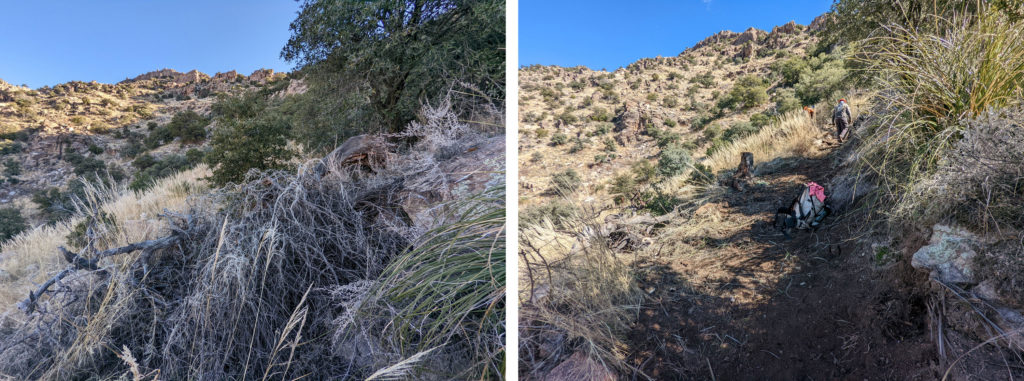
Howdy, readers!
Olivia here, reporting to you live. Well, if there’s one word to describe this past hitch on the Palisades Trail, it’s “grassy.” In addition to all of the grassiness though, the expansive views this trail offered of Tucson’s cityscape to the south and the beautiful Cathedral Rock formation to the west were definitely highlights of the work week. The simultaneous contrast between a sprawling cityscape on the horizon and Sabino Creek’s lush riparian corridor nestled deep into the canyon below also serves as an important reminder of Wilderness conservation’s neat victory in urban wildland areas.


For the Palisades Trail, the Wild Stew Field Crew’s main objective for its restoration was removing overgrown grasses caused by the 2020 Bighorn Fire. Interestingly, and according to a USDA report on rangeland grass recovery, “When a fire sweeps through, it takes the dead plant material from the surface, but grass grows back quickly because most of the plant is below ground and escapes long-term damage.” Well, that explains a lot… because on some parts of this trail, the grass was as tall as me! Work mainly consisted of plucking and popping grasses, yuccas, and sotols out of the tread, as well putting in a whopping total of 33 drains and 15 check steps! So it’s safe to say that as of this past week, the already-stunning lower 1.3 miles of the Palisades Trail got a bit of a beauty touch-up that hikers will surely appreciate.


Along with work, there is always play on this crew. Our camp was situated just along Sabino Creek, which brought plenty of opportunity to take a quick post-work dip in the refreshingly cold pools nearby. This idyllic camp location also brought many visitors through, like the father and son who spent Saturday night with us on their weekend backpacking trip. There’s not much that beats exchanging our backgrounds, stories, and purposes of being out in the backcountry over a nice campfire, and of course nighttime chocolate was exchanged with our new friends! I should also point out that the crew advanced in their musical abilities on this hitch, thanks to Sam who packed in his recorders and sheet music for daily serenades.

During one of our work days, some very special visitors with a very special mission hiked very far up the trail to host a series of interviews with us! Host Stan Bindell and videographer Craig Johnson of the “Preserving Arizona Wilderness” YouTube channel documented our work being done in the Pusch Ridge Wilderness and had some fun questions for each of the crew members pertaining to our shared love for wild places. Make sure to stay tuned for this new video!
On the flip side of this extremely fun work week, we sadly say goodbye to our crew member John as he switches his career path to developed recreation, working in some beautiful places such as the Gila Cliff Dwellings in New Mexico and throughout the Santa Catalinas following that. As for the us on the Wild Stew Field Crew, this is our last hitch in the Catalinas for now, but the past month and a half of working in this special range with some awesome partners in the Forest Service has been nothing short of amazing.
Catch us further north over the next few months as we tackle invasive plants in Fossil Creek, replant native trees at Paria Beach along the Colorado River in the Glen Canyon National Recreation Area, and begin restoration work on the Highline Trail!








